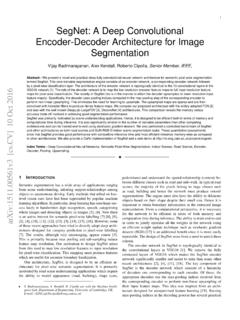Transcription of SECTION - A RESIDENTIAL ROAD AND FOOTPATH …
1 SECTION - A RESIDENTIAL road AND FOOTPATH STANDARDS. Introduction This design guide shall be used in association with the standard specification for private RESIDENTIAL , industrial and commercial development document. The standard specification is derived from the Highways Agency Specification for Highway Works. Design, Setting-out, Construction, Completion and Maintenance of the Works. The Developer shall be responsible for the true and proper design, setting-out, construction and completion of the works. If at any time during the progress of the works any error or omission shall appear or arise in the design, position, levels, dimensions, or alignment of any part of the works, the Developer on being required so to do by the Engineer shall at his own cost rectify such error or omission to the satisfaction of the Engineer, unless such error or omission is based on incorrect data supplied in writing by the Engineer, in which case the cost of the same shall be borne by the Engineer.
2 The checking of any design, setting-out or any line or level by the Engineer shall not in any way relieve the Developer of his responsibility to design, construct, complete and maintain the works until the Final Certificate of Completion has been issued and the roadworks adopted accordingly. Philosophy and Objectives This revision of the design guide has been introduced to reflect the County Borough Council's commitment to reducing accident casualties by requiring developers to incorporate traffic calming principles into their design layouts. There is also a requirement to provide facilities for disabled persons and cyclists and to make provision for buses to penetrate RESIDENTIAL areas.
3 It is also a response to the new version of "Design Bulletin No. 32" (DB32), issued by the Department of the Environment, Department of Transport and the Welsh Office and "Places Streets & Movement" A companion guide to DB32 RESIDENTIAL roads and footpaths issued by the Department of the Environment, Transport and the Regions. The principles and objectives of the design guide are aimed at allowing developers to create layouts which have a distinctive character in their built environment and landscaping, whilst at the same time applying design standards which will achieve a safe provision for pedestrians, cyclists and motor vehicles.
4 These guidelines will permit a more flexible approach by the developer who nevertheless must have regard to the function and role of the various categories of road involved. The principles of traffic calming are being introduced in acknowledgement of research which has shown that at 40 most children struck by cars are killed, at 30 half are killed, but at 20 only 1 child in 20 is killed. It is desirable that road layouts are now produced which will keep traffic to the recommended speeds for the appropriate classification of the road , and indicated later in this guide.
5 There would Issue: 1 Revision: Date: July 2000 1. appear to be advantages to developers if 20 speed limit zones were introduced within an area, in terms of the ability to successfully market the new housing. The factors which generally influence any decision on the need for traffic calming can be summarised as follows:- (a) Volume of traffic using the toad. (b) Number of pedestrians crossing the road . (c) Number of relevant accidents along the road . (d) Speed at which vehicles travel. (e) Use of the road by extraneous traffic traffic using a particular road because of congestion on an adjacent road .
6 Issue: 1 Revision: Date: July 2000 2. Design Factors and Principles There are a number of factors to be taken into account: the needs of pedestrians and vehicles have already been mentioned, but in specific terms these comprise several elements - the carriageway, the footway - the cycleway, as part of the highway, other footpaths separate from the carriageway, car parking and garaging. These elements inter-relate in many ways and a dominant consideration in that relationship is the potential conflict of pedestrians and vehicles. The design of RESIDENTIAL layouts must seek to take account of this relationship and according to circumstances there may be scope for varying degrees of separation of pedestrians and vehicles.
7 The pedestrian network should facilitate journeys from the home to shops, schools, playgrounds, bus stops or railway stations and to other local facilities. The location of uses within the development should also be related to the configuration of the network as for example, in the siting of facilities for the old, the handicapped or the very young. The design of the carriageway itself must meet operational and safety requirements. The adoption of physical design constraints will ensure more effective speed control than the use of legislative measures. Guidance on vehicle parking and garaging is that it shall be off the highway, either inside the curtilage of dwelling or in parking squares and garage compounds or courts.
8 The location should be such that there can be natural surveillance of vehicles from the owners' properties. Cyclists are one of the most vulnerable groups of road users. It would be unreasonable to expect a developer to provide for cyclists on a small development. However on the larger developments, consideration should be given to the provision of facilities so as to encourage such users. Cases may arise where shared pedestrian and cycle facilities will be appropriate. These guidelines have been prepared so as to permit a flexible approach by the developer whilst ensuring that the designs create safe, convenient, nuisance free and secure surroundings that are visually attractive and economical to construct and maintain.
9 Whilst the standards contained within the guide give details of design arrangements which will be acceptable to Rhondda Cynon Taff County Borough Council, alternative arrangements which conform to the principles outlined in the guide can also be put forward for consideration. Providing the standards set out in this guide are adhered to, the following areas will normally be recommended for adoption. - Carriageways and associated general purpose parking bays which lie between carriageway and footway. - Footways. - Footpaths or combined FOOTPATH /cycleways linking to adopted roads.
10 - road margins/verges. - Visibility splays and zones. - Roundabouts Issue: 1 Revision: Date: July 2000 3. - Embankments and cuttings - Highway drainage, culverts and the inlet and outlet structures - Highway structures such as road and foot bridges Developers should note that the geometrical requirements of the guide should be met even when adoption is not intended. When considering into which category a road should be placed for design standards due account needs to be taken not only of the number of properties being served off that road but also the added number of properties served by road /s with direct access onto the road being considered if an approach road served 140 dwellings but an access road serving 80 dwellings had a junction with it the relevant classification would be A.






